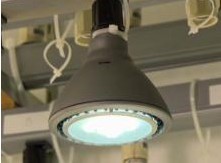The light bulb aisle isn't as simple as it used to be. From CFLs to LEDs to new halogen incandescents, there are a lot of choices. With new federal regulations about to take effect, it's a good time to consider your lighting options.
New federal rules on energy efficiency take effect in January and start the official phase out of standard incandescent light bulbs. There's no need to hoard them, though. The most popular 60-watt size can be made until 2014. In the meantime, the good news is that alternatives are improving.
Consumer Reports tested light emitting diodes, or LEDs, which use even less energy than CFLs. Testers tried the bulbs in a lab and at home.
“You want a light bulb that's as close to the incandescent. It has warm color. This LED happens to be a lot like that,” said tester Kimberly Janeway.
LED bulbs are very expensive and can cost anywhere from $17 for a table lamp bulb to more than $60 for a floodlight, but they can be worth it.
“Even with an LEDs high cost, you can still save $100 or more over its life compared to a standard incandescent,” said Consumer Reports’ Bob Markovich.
LEDs also last much longer, some as long as 9,000 hours. Incandescents only last 1,000 to 2,000 hours.
"LEDs have some distinct advantages over CFLs. They reach full brightness instantly, and some are also better at dimming,” Markovich said.
Not all LEDs are good at distributing light. A Sylvania 60-watt Ultra LED shines most of its light up towards the ceiling, which is not very helpful for reading.
For table or floor lamps, Consumer Reports recommends the $40 Philips Ambient. It's the equivalent of a 60-watt incandescent bulb and claims to last almost 23 years.
For outdoor floodlights, the EcoSmart bulb (Par 38) costs $45 and promises to last even longer.
If you replace an incandescent bulb with an LED, Consumer Reports says it will take four to 10 years before you recoup the costs and start saving. CFLs cost much less and will save you money much sooner.













